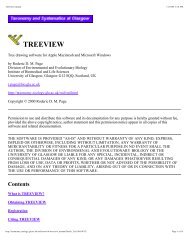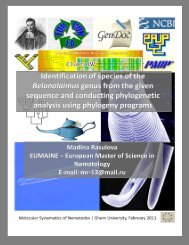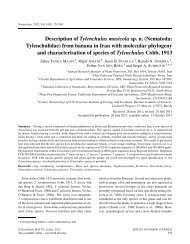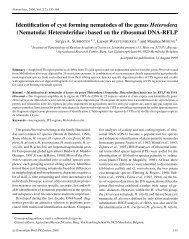Variations in ribosomal DNA sequences and phylogeny of - Russian ...
Variations in ribosomal DNA sequences and phylogeny of - Russian ...
Variations in ribosomal DNA sequences and phylogeny of - Russian ...
You also want an ePaper? Increase the reach of your titles
YUMPU automatically turns print PDFs into web optimized ePapers that Google loves.
Ribosomal <strong>DNA</strong> <strong>and</strong> <strong>phylogeny</strong> <strong>of</strong> Globodera<br />
Fig. 5. Phylogenetic analysis <strong>of</strong> the ITS1 region <strong>sequences</strong> from 39 populations <strong>of</strong> Globodera <strong>and</strong> two populations <strong>of</strong> Cactodera species.<br />
A: One <strong>of</strong> the 312 most parsimonious trees with a length <strong>of</strong> 180 (number <strong>of</strong> parsimony <strong>in</strong>formative characters = 95; CI = 0.8611; HI<br />
= 0.1389; RI = 0.9483; RC = 0.8166; g1 = � 0.4888) constructed us<strong>in</strong>g PAUP (4.0 beta version) program; B: Neighbour-jo<strong>in</strong><strong>in</strong>gtree<br />
constructed us<strong>in</strong>g us<strong>in</strong>g PAUP (4.0 beta version) program with LogDet method. Bootstrap values below 70% are not given.<br />
et al., 1997), Heterodera zeae (Szalanski et al., 1997), <strong>and</strong><br />
accord<strong>in</strong>g to our unpublished data this heterogeneity is<br />
also observed <strong>in</strong> some populations<strong>of</strong> cyst-form<strong>in</strong>g nematodes.<br />
ITS heterogeneity re� ects the result <strong>of</strong> evolutionary<br />
<strong>in</strong>teractionsbetween populations<strong>and</strong> between species.<br />
The multiple copies <strong>of</strong> r<strong>DNA</strong> are considered not to evolve<br />
<strong>in</strong>dependently, but to be homogenized <strong>in</strong> the process <strong>of</strong><br />
concerted evolution (Hillis & Dixon, 1991). Blok et al.<br />
(1998) proposed that the results <strong>of</strong> their work on the comparison<br />
<strong>of</strong> G. pallida <strong>sequences</strong> would <strong>in</strong>dicate that <strong>in</strong><br />
many British G. pallida populations the process <strong>of</strong> homogenization<br />
to a uniform repeat type is still <strong>in</strong>complete,<br />
<strong>and</strong> small numbers <strong>of</strong> repeat types are present which could<br />
have arisen from hybridisation <strong>in</strong> their ancestry between<br />
<strong>in</strong>dividuals with dist<strong>in</strong>ct <strong>ribosomal</strong> genotypes. In pr<strong>in</strong>ciple,<br />
this explanation could also be applied to our data for<br />
G. rostochiensis.<br />
Sequence variations <strong>in</strong> the ITS regions <strong>of</strong> the r<strong>DNA</strong><br />
genes <strong>in</strong> populations <strong>of</strong> G. rostochiensis <strong>and</strong> G. pallida<br />
have been studied earlier (Ferris et al., 1995; Szalanski<br />
et al., 1996; Thiéry & Mugniéry, 1996; Bulman & Marshall,<br />
1997; Blok et al., 1998; Kushida et al., 1998). Sequence<br />
data obta<strong>in</strong>ed dur<strong>in</strong>g our study generally correspond<br />
to previouslypublishedsequence data. Some differences<br />
between <strong>sequences</strong>may be due to a natural variation<br />
with<strong>in</strong> populations. However, artefacts dur<strong>in</strong>g ampli� ca-<br />
Vol. 2(6), 2000 601
















